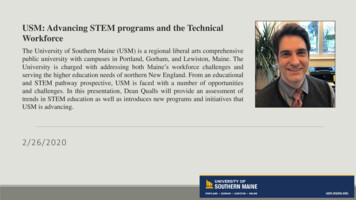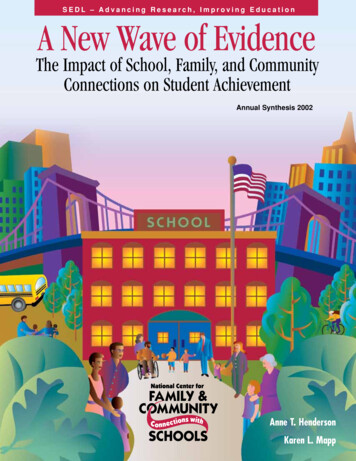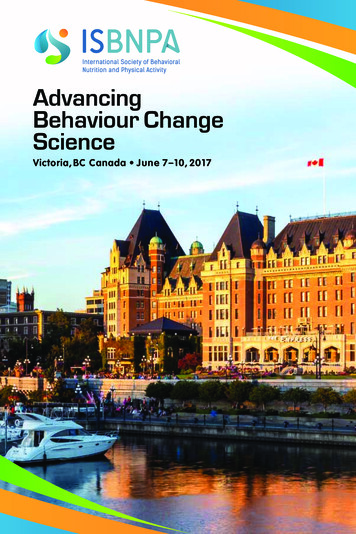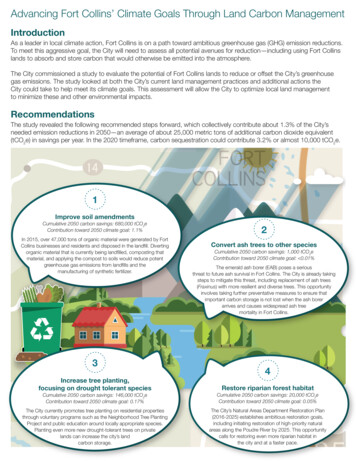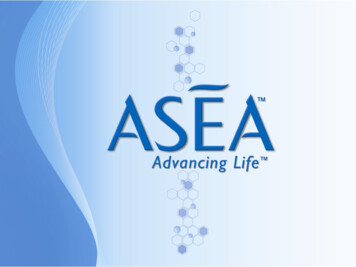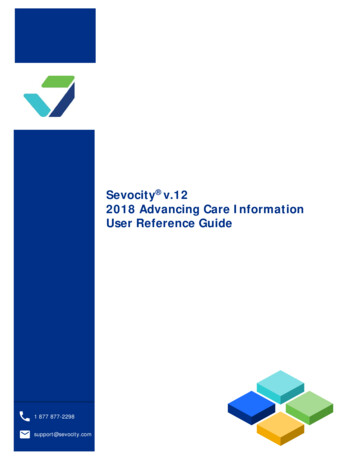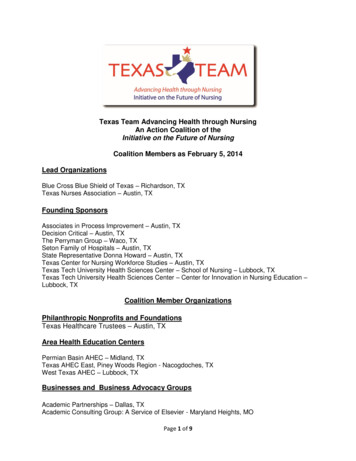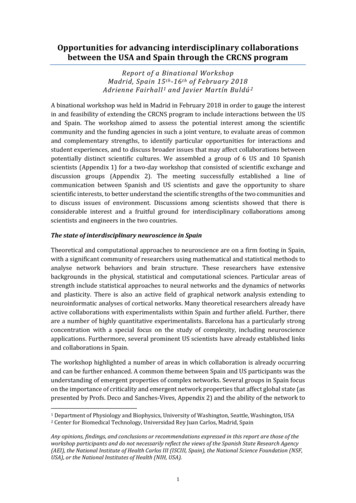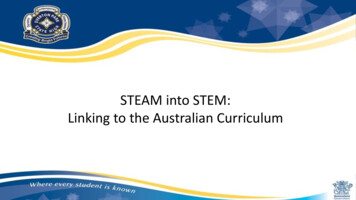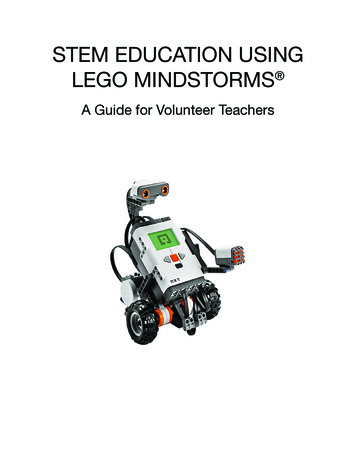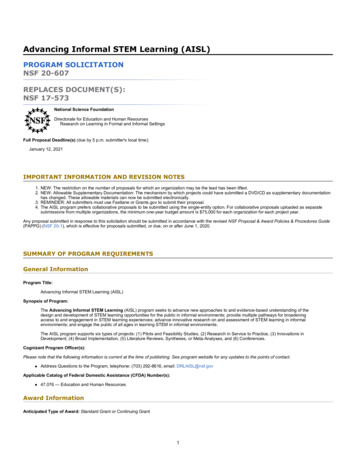
Transcription
Advancing Informal STEM Learning (AISL)PROGRAM SOLICITATIONNSF 20-607REPLACES DOCUMENT(S):NSF 17-573National Science FoundationDirectorate for Education and Human ResourcesResearch on Learning in Formal and Informal SettingsFull Proposal Deadline(s) (due by 5 p.m. submitter's local time):January 12, 2021IMPORTANT INFORMATION AND REVISION NOTES1. NEW: The restriction on the number of proposals for which an organization may be the lead has been lifted.2. NEW: Allowable Supplementary Documentation: The mechanism by which projects could have submitted a DVD/CD as supplementary documentationhas changed. These allowable materials can now be submitted electronically.3. REMINDER: All submitters must use Fastlane or Grants.gov to submit their proposal.4. The AISL program prefers collaborative proposals to be submitted using the single-entity option. For collaborative proposals uploaded as separatesubmissions from multiple organizations, the minimum one-year budget amount is 75,000 for each organization for each project year.Any proposal submitted in response to this solicitation should be submitted in accordance with the revised NSF Proposal & Award Policies & Procedures Guide(PAPPG) (NSF 20-1), which is effective for proposals submitted, or due, on or after June 1, 2020.SUMMARY OF PROGRAM REQUIREMENTSGeneral InformationProgram Title:Advancing Informal STEM Learning (AISL)Synopsis of Program:The Advancing Informal STEM Learning (AISL) program seeks to advance new approaches to and evidence-based understanding of thedesign and development of STEM learning opportunities for the public in informal environments; provide multiple pathways for broadeningaccess to and engagement in STEM learning experiences; advance innovative research on and assessment of STEM learning in informalenvironments; and engage the public of all ages in learning STEM in informal environments.The AISL program supports six types of projects: (1) Pilots and Feasibility Studies, (2) Research in Service to Practice, (3) Innovations inDevelopment, (4) Broad Implementation, (5) Literature Reviews, Syntheses, or Meta-Analyses, and (6) Conferences.Cognizant Program Officer(s):Please note that the following information is current at the time of publishing. See program website for any updates to the points of contact.Address Questions to the Program, telephone: (703) 292-8616, email: DRLAISL@nsf.govApplicable Catalog of Federal Domestic Assistance (CFDA) Number(s):47.076 --- Education and Human ResourcesAward InformationAnticipated Type of Award: Standard Grant or Continuing Grant1
Estimated Number of Awards: 58 to 85Pending availability of funds, it is anticipated that about 10-15 Pilots and Feasibility awards, 8-10 Research in Service to Practice awards, 10-12 Innovations inDevelopment awards, 2-3 Broad Implementation awards, 8-10 Literature reviews, syntheses, and/or meta-analyses awards, and 12-16 Conference awards willbe made. AISL will also fund 4-9 awards made through the EAGER, RAPID, Research Coordination Networks (RCN) mechanisms, and 4-10 CAREER awardsand REU supplements.Anticipated Funding Amount: 30,000,000 to 39,000,000Limits for funding requests of AISL proposals are as follows: (1) Pilots and Feasibility projects: up to 300,000 with durations up to two years; (2) Research inService to Practice projects: from 300,000 to 2,000,000 with durations from two to five years; (3) Innovations in Development projects: 500,000 to 3,000,000 with durations from two to five years; (4) Broad Implementation projects from 1,000,000 to 3,000,000 with durations from three to five years; (5)Literature Reviews, Syntheses, or Meta-analyses projects up to 250,000 with durations of up to two years; and (6) Conferences up to 250,000 with durationsof up to two years.Eligibility InformationWho May Submit Proposals:The categories of proposers eligible to submit proposals to the National Science Foundation are identified in the NSF Proposal & AwardPolicies & Procedures Guide (PAPPG), Chapter I.E. Unaffiliated individuals are not eligible to submit proposals in response to this solicitation.Who May Serve as PI:There are no restrictions or limits.Limit on Number of Proposals per Organization:There are no restrictions or limits.Limit on Number of Proposals per PI or Co-PI: 3An individual may be included as a Principal Investigator (PI) /co-PI on no more than three (3) proposals submitted to the program deadline.Proposal Preparation and Submission InstructionsA. Proposal Preparation InstructionsLetters of Intent: Not requiredPreliminary Proposal Submission: Not requiredFull Proposals:Full Proposals submitted via FastLane: NSF Proposal and Award Policies and Procedures Guide (PAPPG) guidelines apply. The completetext of the PAPPG is available electronically on the NSF website at: https://www.nsf.gov/publications/pub summ.jsp?ods key pappg.Full Proposals submitted via Grants.gov: NSF Grants.gov Application Guide: A Guide for the Preparation and Submission of NSF Applicationsvia Grants.gov guidelines apply (Note: The NSF Grants.gov Application Guide is available on the Grants.gov website and on the NSF websiteat: https://www.nsf.gov/publications/pub summ.jsp?ods key grantsgovguide).B. Budgetary InformationCost Sharing Requirements:Inclusion of voluntary committed cost sharing is prohibited.Indirect Cost (F&A) Limitations:Not ApplicableOther Budgetary Limitations:Other budgetary limitations apply. Please see the full text of this solicitation for further information.C. Due DatesFull Proposal Deadline(s) (due by 5 p.m. submitter's local time):January 12, 2021Proposal Review Information CriteriaMerit Review Criteria:National Science Board approved criteria. Additional merit review criteria apply. Please see the full text of this solicitation for further information.2
Award Administration InformationAward Conditions:Standard NSF award conditions apply.Reporting Requirements:Additional reporting requirements apply. Please see the full text of this solicitation for further information.TABLE OF CONTENTSSummary of Program ionProgram DescriptionAward InformationEligibility InformationProposal Preparation and Submission InstructionsA. Proposal Preparation InstructionsB. Budgetary InformationC. Due DatesD. FastLane/Grants.gov RequirementsNSF Proposal Processing and Review ProceduresA. Merit Review Principles and CriteriaB. Review and Selection ProcessAward Administration InformationA. Notification of the AwardB. Award ConditionsC. Reporting RequirementsAgency ContactsOther InformationI. INTRODUCTIONAbout the Advancing Informal STEM Learning ProgramCONTEXTOver the last several decades there has been a growing understanding and acknowledgment that learning occurs across the lifespan and in places and spacesbeyond schools or the school day. Developments in technology continue to influence the ways and means for learning, including 24/7 access to information,tools for learning collaboratively, personalization of learning, and authentic/deeper contributions to scientific processes and studies. The social context of scienceis also changing. The publics trust in the scientific enterprise means that questions of knowledge, evidence, and distinguishing among knowledge, views, andvalues are ever-present in media and in our daily discussions and deliberations (Dickel, 2016; NAS, 2015). Further, people expect to have a stronger voice inscience. This social context has contributed to a changing role of science in people's lives, which has resulted in the shifting dynamics of learning (e.g., do-ityourself movement, public participation in scientific research, access to low cost, high quality sensors, and other tools to conduct one's own investigations), andinterest in the interconnections and interdisciplinary of science with other disciplines (e.g. science, technology, engineering, the arts, and mathematics). Inaddition, advances in brain research, cognition, and other domains have stimulated interest in expanding notions of how early in life the learning of science,technology, engineering, and mathematics (STEM) can occur. There is unequal distribution of and access to quality STEM learning experiences for individuals,family, and communities. Likewise, the sectors that comprise the informal STEM education field (e.g., mass media, museums/zoos/aquaria, after-school, scienceoutreach, citizen science, cyber-enabled learning, science communication, among others) have professionals of varying knowledge and capacities with respectto teaching and learning STEM.Almost any environment can support informal science learning, such as a home, a museum, a library, a street, or a virtual or augmented reality game.Information networks, mobile media, and social networks transform educational possibilities and create opportunities for seamless learning environments.Informal learning environments are, in principle, accessible to all learners, and evidence suggests they have particular potential for supporting learners fromunderrepresented groups (National Research Council, 2009). These settings offer learners direct access to compelling phenomena in the natural and designedworld, and powerful representations of those phenomena. Ubiquity, digital networks, and lack of formal accreditation procedures mean that anyone withappropriate expertise can facilitate STEM learning in the informal world.PROGRAM GOALSThe AISL program is situated within the Division of Research on Learning in Formal and Informal Settings (DRL). DRL's mission is to cultivate and catalyzefundamental and applied research and development (R&D) to improve the learning of science, technology, engineering, and mathematics for the nation. Insupport of this mission, AISL seeks to (a) advance new approaches to and evidence-based understanding of the design and development of STEM learning ininformal environments; (b) provide multiple pathways for broadening access to and engagement in STEM learning experiences; (c) advance innovative researchon and assessment of STEM learning in informal environments; and (d) engage the public of all ages in learning STEM in informal environments.The AISL program's priorities are: (1) Maximizing Strategic Impact, (2) Enhancing Knowledge-Building, (3) Promoting Innovation, (4) Advancing Collaboration,(5) Strengthening Infrastructure and Building Capacity, and (6) Broadening Participation. Through these priorities, described in more detail throughout the3
solicitation, the program contributes to STEM engagement and literacy, workforce development, and educational success. It may also narrow the gap betweenthe advancements in scientific discovery and the publics understanding of science.II. PROGRAM DESCRIPTIONWhat is informal science, technology, engineering and mathematics (STEM) learning?It is "lifelong learning in science, technology, engineering, and math (STEM) that takes place across a multitude of designed settings and experiences outside ofthe formal classroom" (Center for the Advancement of Informal Science Education website). For more information see the Center for the CAISE website,http://www.informalscience.org.AISL program investments should be of interest and utility to public audiences, informal STEM practitioners, and decision-makers. All proposals mustarticulate clear rationales describing why a project is primarily informal and how it adds value to the informal STEM learning community.The products of AISL investments may include, but are not limited to, exhibitions and programs in museums, zoos, aquaria, botanic gardens/arboreta,planetariums, nature centers, parks, libraries, and other environments; science communication; after-school and out-of-school time (OST) programs; radio,television, film, or media programs or series; Do-It-Yourself (DIY)/maker initiatives; opportunities for the public to engage in research including crowd-sourcingand citizen science; on-line and other digital experiences (e.g., games, simulations, social media, mobile computing, distributed networks, and massive onlineopen courses); and research findings that articulate what works, for whom, why, and in what contexts.Given that almost any environment can support informal science learning, there is an opportunity to understand how learners can be supported to make bridgesbetween what they learn in one setting and what they learn in another setting. Thus, projects may choose to include how informal learning practices connect withSTEM-related frameworks and curricula, college and career readiness standards, or other educational settings.Audiences for AISL ProjectsAISL projects engage participants drawn from both public and professional audiences.Public audiences may include learners of any age, educational level, geographic, or cultural background, including those from groups underrepresented inSTEM or under-served in STEM, including geographic regions and economically challenged communities. The AISL program is keenly interested in projects thatsupport understanding issues of access to informal STEM learning opportunities for individuals/groups from populations typically underrepresented in STEM,people in rural as well as urban communities, adults across the lifespan, early childhood, and intergenerational and family groups.Professional audiences are individuals involved in any aspect of research or development of STEM learning by the public in informal environments. Audiencescould include STEM educators, evaluators, education and learning researchers, technologists, media professionals, or STEM professionals doing outreach ininformal settings. Graduate students and post-docs may also be included as professional audiences.Proposals may focus on public audiences, professional audiences or both. Proposals should be clear about their audience(s) and how the project's design andSTEM learning component(s) are relevant and appropriate for the proposed audiences and age levels.STEM content areasA note about STEM-related fields and STEM-related occupations: STEM is an acronym for science, technology, engineering, and mathematics; STEM includesthe social, behavioral, and economic sciences. The term "STEM-related fields" is used in this solicitation to refer to these disciplines, their many sub-disciplines,and related fields that require knowledge and skills related to one or more STEM disciplines.Content may focus on any areas of STEM that NSF supports, including interdisciplinary learning and learning that positions STEM within meaningful personal,cultural or societal frameworks. The proposals should discuss the STEM content area(s) in sufficient depth to provide a clear understanding of concepts, topics,processes, and associated skills that are conveyed to the audience. Topics should be relevant to the age levels of proposed audience(s). Projects may integrateSTEM and art or the humanities, as long as the primary goal is to enhance STEM learning in informal environments.PrioritiesThis section describes six priorities that the AISL program believes are essential for achieving its goals. These priorities are also strategies to incorporate asapproaches to the work. Every project does not need to address every priority. Thus, proposals should be clear about how the priorities are being addressed.These priorities should be addressed at the level appropriate to the proposal type and amount of funding requested.1. Maximizing Strategic Impact. Strategic Impact refers to how a project addresses important areas for continued development and advances the informalSTEM learning field overall (not simply the project impact for the target audiences or communities). Strategic suggests planned intent or focus and shouldaddress the question: What approach or model does the project offer for advancing the field or a sub-component of the field? Proposers should think about whois needed on the project to ensure that a strategic focus is fostered.To be strategic, impact must go beyond project-level impact. How could others in the field be able to implement the approach or model created/investigated as aresult of the project? Note that strategic impact can be achieved regardless of the size of the organization (or the population of the communities that they serve)or the size of the target audience.2. Enhancing Knowledge-building. AISL projects are expected to build knowledge with respect to informal STEM education. Projects must describe and makea strong case for how a project advances the knowledge base of the informal STEM learning field through research, evaluation, or a combination of researchand evaluation. The theoretical and empirical justification for the proposed project must be clearly articulated. Knowledge generation may focus on developing,testing, and/or implementing innovative research, models, resources, and tools for informal learning environments. Foci of investigations may include, forexample, "what is happening," "to what extent," "why," "how," "what works for whom," and "under what circumstances." The "Discover Research" tab on thehttp://www.informalscience.org website may be helpful in finding current research, literature reviews, research agendas, etc. related to learning STEM in informalsettings.Projects should build from the current literature and practice. Projects may also consider building from or critiquing relevant research agendas or literaturesabout informal STEM learning that have been developed in recent years. This may be one way projects can contribute to the development of the field. Some4
current frameworks are available at ions of research and evaluation vary across the field of informal STEM education. It is not the goal of this solicitation to set definitions for theseapproaches. Instead, the AISL program seeks to advance the collective understanding of learning STEM in informal environments and to provide appropriatemeans for communicating what has been learned. Thus, each proposal should identify how it builds knowledge. It should make a case for how it is doing so,using appropriate resources from research and evaluation (CAISE, 2011; Friedman, 2008; IES and NSF, 2013). Support for evaluation is available at the"Design Evaluation" tab on the http://wwwinformalscience.org website.With respect to learning, proposals must describe measures of learning outcomes for the target audiences, including how the chosen measures are appropriatefor the proposed work and of practical interest and utility to practitioners and decision makers. Recent reports encourage measuring learning outcomes in suchterms as interest, engagement, attitude, motivation, behavior, identity, persistence and 21st century skills (Friedman, 2008; National Research Council 2009,2012, 2015). The AISL program recognizes the complexities of measuring STEM learning in informal environments. The program welcomes innovative andexploratory assessment methods that draw from knowledge and practice of learning across environments.3. Promoting Innovation. In a manner similar to NSF programs that fund projects at the frontiers of STEM research, AISL seeks to fund projects at the frontiersof STEM learning in informal environments that will advance the state-of-the-art. Depending on the discipline or sector, innovation may be framed in differentways and serve different purposes. Innovation may build on or extend current work or it might take that work in a totally different direction. In the informaleducation field, innovation might address immediate challenges and opportunities; anticipate different structures, functions, and purposes of informal STEMeducation; challenge existing assumptions about learning and learning environments; or envision the future needs of diverse learners, educators, and STEMprofessionals in the U.S. In addition, personalized learning options and participatory learning environmen
open courses); and research findings that articulate what works, for whom, why, and in what contexts. Given that almost any environment can support informal science learning, there is an opportunity to understand how learners can be supported to make bridges
